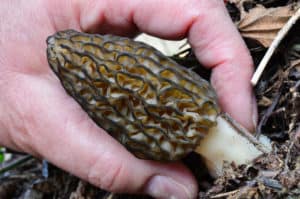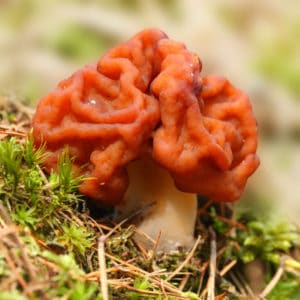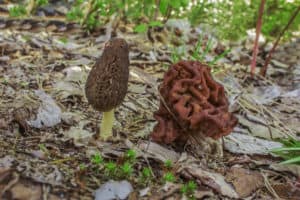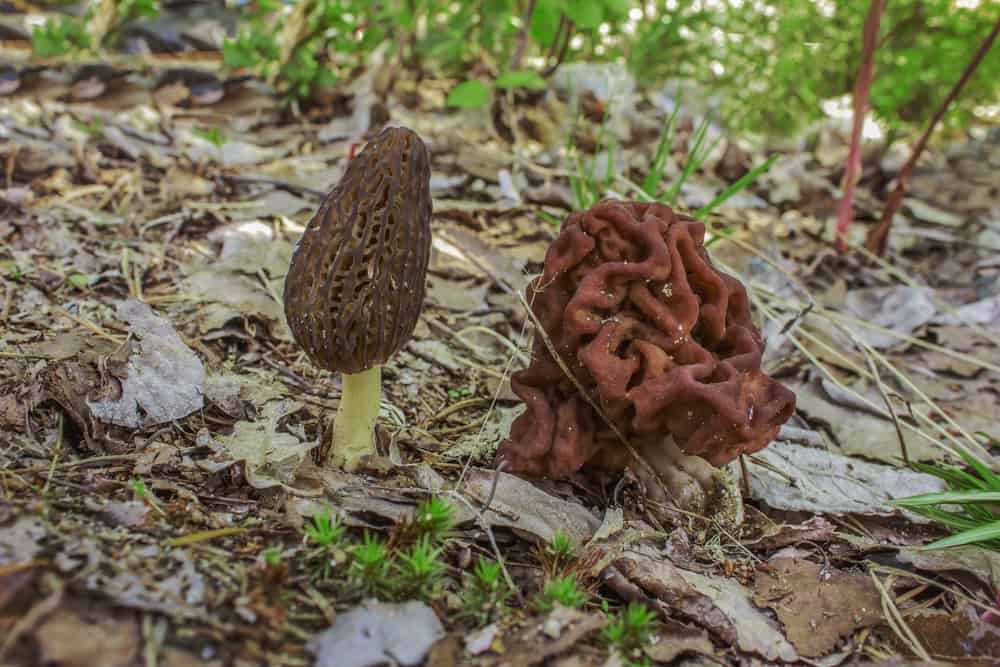Ways to Identify True Morels vs. False Morels
Morel mushrooms, a wild species of mushrooms, are one of the most desired fungi around the world. There are even events in various parts of the world in which participants collect morels in a specific timed competition.

However, as much as true morels are sought out through events, expeditions, or even just your own mushroom hunt, many people fall prey to false morels. This is why false morels account for a significant percentage of mushroom poisoning around the same time of the year when the search for true morels begins.
If you’re an amateur, there are even higher chances of mistaking false morels for the true species, which is why it is important to know the difference between the two.
What are False Morels?
False morels are a species of mushrooms that look similar to true morels and as a result are often mistaken for. The two most common species of false morels are Gyromitra esculenta and Verpa bohemica.
Since these are the scientific names of this particular fungi, it’s likely you haven’t heard of these, but you might’ve heard of their common names instead i.e. Beefsteak mushroom, Red mushroom, and Early morel mushroom.
These are some of the most commonly found false morels and even though they can be easily distinguished from true morels, more often than not people can’t distinguish between the two.
When do False Morels Grow?
False morels grow in the same season as true morels, meaning late spring. However, depending on the location they can also grow in several areas around summer or early fall. Typically, the time of the year in which false morels grow is May to June.
Basically false morels require warm soil for growth and so areas that have around 60-degree temperature in the afternoon, that decreases to about 50 degrees, is the ideal growing area for false morels to fully develop into mature mushrooms.
Morels require 12-15 days to fully mature into a grown mushroom if they get the resources they need. Once again, this is the same time when true morels are growing which is why during this time period there are heightened cases of mushroom poisoning due to people gathering false morels instead of true morels.

Where do False Morels Grow?
False morels grow in places such as ravines, valleys, or pond edges. Similarly, Gyromitra can also grow under conifer trees, on forest grounds.
It can be said that false morels grow in the same habitat as true morels which make it easier to mistake the two if you’re out hunting for morels.
False morels can grow in a specific area in a few numbers or an entire bunch of morels. Simultaneously, morels can keep growing in the same spot the next year, and for consecutive years afterward.
However, there is also the chance that they might not grow in the same spot the next year even if they did for the previous few years, and may suddenly disappear.
Facts on False Morels
False morels were the most common cause related to mushroom poisoning after the World War II, and still take a significant portion of mushroom poisoning cases today.
False morels feed on decaying matter, making them have the ability to digest almost everything except plastics!
What do False Morels Look Like?
False morels have a unique appearance to them. For false morels, the mushroom cap is located at the very end of the mushroom stem. The cap is brownish-red in color and can continue to change color to blackish red as they mature.
The caps also have a folded brain-like appearance, or may have a saddle-shaped appearance if they’re still young. The insides of the stems of false morels are pith-filled with a cotton-like structure. False morels typically grow from 2 inches up to 10 inches.

Difference Between True Morels and False Morels
To clearly distinguish between true morels and false morels, there are two features to keep an eye out for. These include the following:
- Look at the Caps: true morels have a pitted, rigged-like structure on the mushroom caps. You can clearly identify a true morel from the structure of their caps, that differs from the brain-like structure of false morels.
- Observe the Stem: false morels can also be distinguished from their stems. If you cut open a true morel, it should have a hollow stem unlike false morels that have a cotton mycelium filling in between the stalk.
- Additionally, the mushroom caps of a true morel should run up till the mid or end of the stem, but for false morels the mushroom caps can only be seen at the very end of the stem if you cut open the mushroom.
Why are False Morels Poisonous?
False morels are poisonous on ingestion or even just inhaling their fumes due to the chemical found in them i.e. gyromitrin. Gyromitrin when ingested by a person in its raw form is decomposed into a substance called monomethylhydrazine.
If you’re thinking, so how is that dangerous? The same chemical that is present in rocket fuel is found in your body if you ingest false morels!
Many still believe that false morels can be ingested if you properly cook them before eating them. However, false morels can result in mushroom poisoning due to the fumes their chemical releases even if you’re just boiling them in water and standing close to the pot.
Meanwhile, if you’re cooking them the chemical can be removed during the cooking process but you can never be sure enough that they’re completely safe to consume when you’re doing cooking them since even a tiny amount of the chemical substance left in the mushroom can result in symptoms of mushroom poisoning.
What are the Symptoms of False Morel Poisoning?
Upon ingesting or inhaling false morels, the toxins present within these mushrooms can cause mushroom poisoning whose symptoms can be seen within a 6-48 hour period after taking these poisonous species.
False morels are especially toxic to the liver, gastric tract, and the central nervous system of the body.
Symptoms include nausea, abdominal cramps, headache, weakness, diarrhea, vomiting, and bloating. These are considered ‘mild’ symptoms that can be treated if consulted immediately.
However, if the person is left untreated for a prolonged duration the symptoms can develop into jaundice, brain coma, and seizures.
False morels decrease the process of blood clotting in the body which leads to more bleeding and bruising in the body. While it is rare, these symptoms can lead to death in some cases as well if not treated on time.
What Precautionary Methods Can You Take?
To ensure you’re not another one to fall prey to the lookalike false morels and develop mushroom poisoning, you can take several steps to keep yourself safe.
Firstly, if you’re still not experienced enough to differentiate between a true morel and a false morel your best bet is to take a professional mushroom hunter with you to avoid putting yourself at risk.
Secondly, properly observe each morel you collect and look for the differentiating characteristics between a false morel and a true morel.
Lastly, if you inhale or ingest a morel, or any other mushroom, and start seeing symptoms of poisoning consult medical care immediately! Do not wait and go to the hospital as soon as possible to get it looked and treated before it turns serious. You might even want to take a picture of the mushroom you consumed, if you still have some lying around, to show it to the doctor.
References
False morel fungus. (n.d.). Retrieved May 04, 2020, from https://www.sciencedaily.com/terms/false_morel.htm
False Morels. (2018, July 17). Retrieved May 04, 2020, from https://www.thegreatmorel.com/false-morels/
HoferMarch, J. (2017, March 10). Real Vs. False Morel Mushroom. Retrieved May 04, 2020, from https://www.wideopenspaces.com/learn-important-difference-real-false-morel-mushrooms/
Gyromitra esculenta, a false morel. (n.d.). Retrieved May 04, 2020, from http://bioweb.uwlax.edu/bio203/s2013/hammett-_will/facts2.htm




